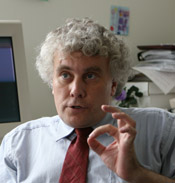 |
 |
|
|
 |
||
| Annual Report | ||
 |
News | |
| MDRC Administration | ||
 |
Directory / Bottin | |
 |
Contact Us | |
 |
Directions / Maps | |
 |
Steering Committee | |
| Research | ||
 |
Events & Seminars | |
 |
MDRC at the forefront | |
 |
McGarry Lecture | |
 |
Cahill Lecture | |
 |
MDRC Core Facilities | |
 |
Scientific Links | |
 |
Education & Employment | |
| Funding | ||
 |
MDRC Grants | |
 |
Donations | |
 |
Non-Profit & Industrial Partners | |
| Medical Information | ||
 |
JDRF | |
 |
CDA | |
 |
Diabetes Quebec | |
 |
ADA | |
 |
IDF | |
 |
NIH / NIDDK | |
 |
Alfediam | |
 |
EASD | |
| Home / About Us > Dr Robert Sladek | 
Contact info Dr Rob Sladek Tel: 1-514-398-5458
Research keywords
|
|
Robert Sladek, MD
Assistant Professor of Medicine
Biographical Sketch
Rob Sladek is an Assistant Professor at the McGill University and Genome Quebec Innovation Centre. He completed undergraduate studies in Engineering Science and Medicine as well as a clinical fellowship in Endocrinology and Metabolism, all at the University of Toronto. His postdoctoral training explored the role of the Estrogen-related receptors in the regulation of fat metabolism and reproduction (with Dr Vincent Gigu�re) and the application of high-throughput genomics technologies to study complex traits (with Dr Tom Hudson). His current research centers on the development of new technologies for studying the dynamics of gene transcription networks in living cells (the Living Microarray Project) and risk factors for type 2 diabetes (the Diabetes Gene Discovery Group). Selected Scientific Contributions
Dr Sladek's scientific contributions centre on establishing the role of gene transcription networks in complex traits. He identified key physiological roles for the orphan nuclear receptor ERRalpha in regulating the balance between lipolysis and lipogenesis and ERRbeta in regulating development of the chorion and trophoblast. He has developed methods to identify transcriptional networks de novo in panels of recombinant congenic mouse strains and to characterize transcriptional effects of cis-regulatory genetic variants that underlie complex genetic traits. Most recently, he collaborated with Drs Froguel, Polychronakos, Posner and Prentki to complete the first genome-wide association study (GWAS) to identify risk loci for type 2 diabetes. Research Interests
Current projects in the laboratory include: The Living Microarray Project. In collaboration with Hans De Sterck (Waterloo), Justin Wan (Waterloo), Tom Hudson (Toronto), Bernhard Bodmann (Houston), Haig Djambazian and Sarav Sundararajan (McGill), I am developing a high-throughput imaging platform to identify and characterize gene transcription networks in living cells. The platform is able simultaneously image hundreds of fluorescent reporter constructs during cell division and differentiation (including myogenesis). Functional characterization of risk loci for type 2 diabetes. In collaboration with Mike Wheeler (Toronto), Jarred Chicoine and Albena Pramatarova (McGill), I am involved in characterizing the effects of diabetes risk loci on beta-cell physiology and particularly the effects of SLC30A8 coding variants on zinc transport, beta-cell viability and insulin secretion. The Gene Regulation in Disease (GRiD) project. In collaboration with Tomi Pastinen, Jacek Majewski and Huan Chu Pham Dang (McGill), I am involved in developing strategies to identify causative genetic polymorphisms that underlie disease risk loci and determine their effects on cell physiology and gene regulation. Nanomedicine Sensors project. This collaboration, with Peter Grutter, Bruce Lennox and John White seeks to develop novel sensors to measure nucleic acid levels in vivo. These technologies, based on atomic force microscopy and gold nanoparticles will be used to provide rapid and sensitive assays to detect single nucleotide polymorphisms and to measure gene transcription from endogenous loci in real time. Diabetes Gene Discovery Group. This multicentre collaboration, with Philippe Froguel, Ghislain Rocheleau, David Serre, Marcin Swiatek, Christian Dina, Nabila Bouatia-Naji, David Meyre, Stephane Cauchy, Martine Vaxillaire, Johan Rung, Lishaung Shen, Alexander Mazur and Constantin Polychronakos seeks to identify genetic variants that predispose to type 2 diabetes. |
|
| ďż˝ Montreal Diabetes Research Center 2018 |
| Home / About Us News Directory / Bottin Contact Us |